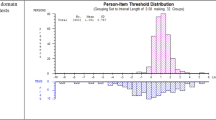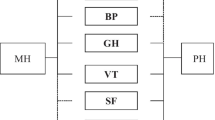Abstract
To compare health-related quality of life (QOL) across groups, researchers have to assure that items of a QOL measure represent the same constructs across groups. This study investigated factorial invariance of the WHOQOL-BREF between a healthy population and populations with diseases using the data from the 2001 National Health Interview Survey (NHIS) in Taiwan. The NHIS was conducted by stratified multistage systematic sampling resulting in responses from 13,010 participants aged 20∼65 who completed the WHOQOL-BREF. The analysis was limited to 5 diseases where at least 200 individuals had that specific single condition; these were pulmonary disease, hypertension, peptic ulcer, sinusitis and liver disease. In this study, confirmatory factor analyses (CFA) on a four-factor model were conducted. Two-group analyses with unconstrained/constrained parameters were conducted to confirm the comparability of CFA factor structures between groups. Generally, the ξ2 discrepancy tests showed that different disease groups and their matched healthy groups shared the same first- and second-order factor loadings. Moreover, different disease groups shared the same first- and second-order factor loadings as well. In other words, after controlling age and gender, same perceptions on the WHOQOL-BREF questionnaire were found between disease and matched healthy groups and across disease groups.
Similar content being viewed by others
References
Leung KF, Tay M, Cheng SW, et al: Hong Kong Chinese version World Health Organization quality of life measure – abbreviated version. (WHOQOL-BREF (HK)), 1997.
J Alonso M Ferrer B Gandek et al. (2004) ArticleTitleHealth-related quality of life associated with chronic conditions in eight countries: Results from the International Quality of Life Assessment (IQOLA) Project Qual Life Res 13 283–298 Occurrence Handle10.1023/B:QURE.0000018472.46236.05 Occurrence Handle15085901
R Arnold AV Ranchor R Sanderman et al. (2004) ArticleTitleThe relative contribution of domains of quality of life to overall quality of life for different chronic diseases Qual Life Res 13 883–896 Occurrence Handle10.1023/B:QURE.0000025599.74923.f2 Occurrence Handle15233502
CLK Lam IJ. Lauder (2000) ArticleTitleThe impact of chronic diseases on the health-related quality of life (HRQOL) of Chinese patients in primary care Fam Prac 17 159–166 Occurrence Handle10.1093/fampra/17.2.159
CLK Lam IJ Lauder TPD. Lam (2003) ArticleTitleThe impact of chronic diseases on health services and quality of life of a Chinese population Asia Pac Fam Med 2 98–106 Occurrence Handle10.1046/j.1444-1683.2003.00064.x
DL Patrick S Kinne RA Engelberg RA. Pearlman (2000) ArticleTitleFunctional status and perceived quality of life in adults with and without chronic conditions J Clin Epidemiol 53 779–785 Occurrence Handle10.1016/S0895-4356(00)00205-5 Occurrence Handle10942859
MAG Sprangers EB Regt Particlede F Andries et al. (2000) ArticleTitleWhich chronic conditions are associated with better or poorer quality of life? J Clin Epidemiol 53 895–907 Occurrence Handle10.1016/S0895-4356(00)00204-3 Occurrence Handle11004416
KG. Joreskog (1971) ArticleTitleSimultaneous factor analysis in several populations Psychometrika 57 409–426
RJ Vandenberg CE. Lance (2000) ArticleTitleA review and synthesis of the measurement invariance literature: Suggestions, practices and recommendation for organizational research Organ Res Methods 3 4–70
InstitutionalAuthorNameThe WHOQOL Group (1998) ArticleTitleThe World Health Organization Quality of Life assessment (WHOQOL): Development and general psychometric properties Soc Sci Med 46 1569–1585
InstitutionalAuthorNameThe WHOQOL Group. (1998) ArticleTitleDevelopment of the World Health Organization WHOQOL-BREF quality of life assessment Psychol Med 28 551–558
InstitutionalAuthorNameThe WHOQOL-Taiwan Group. (2000) ArticleTitleIntroduction to the development of the WHOQOL-Taiwan version Chinese J Public Health (Taipei) 19 315–324
The WHOQOL-Taiwan Group: The User’s Manual of the Development of the WHOQOL-BREF Taiwan Version. 1st rev. ed. Taiwan: Taipei, 2001.
G Yao CW Chung CF Yu JD. Wang (2002) ArticleTitleDevelopment and verification of validity and reliability of the WHOQOL-BREF Taiwan version J Formos Med Assoc 101 342–51 Occurrence Handle12101852
Shih YT, Chang HY, Le KH, et al. Introduction to the National Health Interview Survey (NHIS). NHIS Brief Communication No. 1, June 2002.
Chang FC, Chang HY, Liu HY, Wu SL. Introduction to the National Health Interview Survey (NHIS) Questionnaire design. NHIS Brief Communication No. 3, June 2002.
Hung YT. Sampling design of the National Health Interview Survey. NHIS Brief Communication No. 2, June 2002
Lin SH. Field collection and completeness of data in the National Health Interview Survey. NHIS Brief Communication No. 4, June 2002.
World Health Organization. WHOQOL-BREF: Introduction, administration, scoring and generic version of the assessment – Field trial version. Geneva: WHO, 1996.
KA. Bollen (1989) Structural equations with latent variables John Wiley New York
Yao G, Wang JD, Chen CM, Tsai, YJ. Cross-validation and normative analysis of establishment of the WHOQOL-BREF Taiwan version. Paper presented at the 10th Annual Conference of the International Society for Quality of Life Research, Czech Republic, 2003.
KG Joreskog D. Sorbom (1993) LISREL 8: Structural Equation Modeling With the SIMPLIS Command Language Lawrence Erlbaum Associates Hillsdale, NJ
PM Bentler (1993) EQS Structural Equations Program Manual BMDP Statistical Software Los Angeles, CA
Author information
Authors and Affiliations
Corresponding author
Rights and permissions
About this article
Cite this article
Yao, G., Wu, Ch. Factorial Invariance of the WHOQOL-BREF Among Disease Groups. Qual Life Res 14, 1881–1888 (2005). https://doi.org/10.1007/s11136-005-3867-7
Accepted:
Issue Date:
DOI: https://doi.org/10.1007/s11136-005-3867-7




